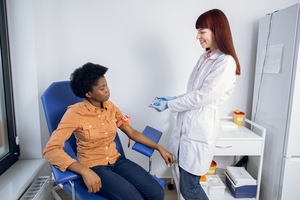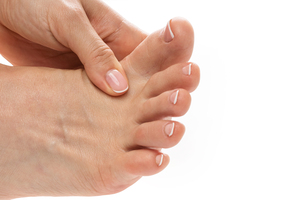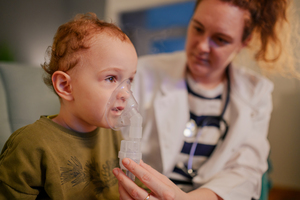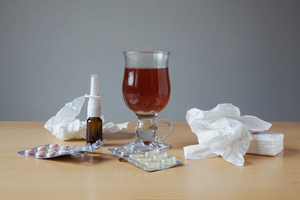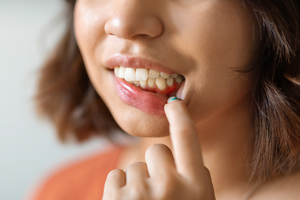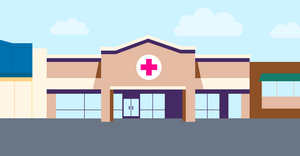Key points
- Omicron variant is highly transmissible and may cause less severe disease and milder symptoms.
- Quarantine is crucial after a positive test, with cities potentially offering free accommodations for those who tested positive.
- Symptoms of Omicron variant may differ from earlier COVID-19 variants, with cold-like symptoms being common.
- CDC guidelines for isolation have changed, now recommending a 5-day isolation period for vaccinated individuals, if symptoms are resolving.
- The article emphasizes the importance of letting go of guilt if you're vaccinated and still contract COVID. Breakthrough infections are becoming more common, especially with the Omicron variant, and the article encourages readers to focus on the steps they've taken to protect themselves and others.

So you tested positive for COVID. Now what?
First, know you’re not alone. The U.S. has surpassed its record for new daily coronavirus cases with a caseload almost doubling that of last winter’s peak, according to The New York Times. These numbers may not even provide a clear picture of everyone who has it, because testing lagged over the holidays and such numbers don’t capture all positive cases detected through at-home tests.
This surge is being accelerated by the Omicron variant, which is highly contagious — and became the dominant strain in the U.S. in December, according to CNN. Thus far, it has appeared that Omicron may cause less severe disease and milder symptoms, according to The New York Times.
Rising cases and long testing lines may give you psychological whiplash back to early pandemic days of spring 2020, but take a moment to remind yourself that these moments in time are not the same. The team at Solv has compiled some recommendations for how to navigate a positive test result in January 2022.
Please note: our suggestions are geared toward vaccinated individuals.
If you are not yet vaccinated, the CDC recommends that you get a shot. The best protection you can have against illness from COVID is to get the vaccine, which is now widely available — and if you are not yet boosted, get a booster shot, which offers maximum protection against the Omicron variant, according to The Washington Post.
Figure out where to quarantine
Omicron is more transmissible than previous variants, according to the CDC. This means it’s extra important to steer clear of others in your home if you have tested positive. Do you have roommates or live in close quarters? Come up with a game plan with others in your household.
Do your research to check out whether your city offers free accommodations for those who have tested positive for COVID or live with someone who has it. For example, people living in New York City can stay in specific accommodations for free, according to NYC.gov. They can also receive medical-grade masks, a pulse oximeter (to monitor oxygen levels in your blood), thermometer and hand sanitizer from contact tracers.
What should you expect?
While some people with breakthrough cases don’t experience symptoms, a positive COVID test is often accompanied by “mild to moderate symptoms” such as a cough, sore throat, muscle aches or low fever, according to The Washington Post. Others may experience headaches, nasal congestion, sneezing or symptoms often linked with the common cold or allergies, according to the Washington Post.
Though data on the latest variant is still emerging, it seems like symptoms that many people who are infected with Omicron (and Delta, as well) have diverged from those three cornerstone signs of early COVID-19 symptoms — fever, cough and loss of smell or taste — that tracked with earlier variants, according to Vox.
At-home care
If you’ve tested positive, stock up on a thermometer and pulse oximeter in case your symptoms decline and you want to share information with your provider, experts say in The Washington Post. Acetaminophen (such as Tylenol) can alleviate pains or discomfort, while cold meds with expectorant could help to reduce congestion, according to The Washington Post.
Remember that these interventions won’t speed up your body fighting off the virus — they might just help make you a bit more comfortable, according to the CDC. Take note of dosage instructions and consider the interaction with existing meds you might be taking.
Fluids with electrolytes like Gatorade and Pedialyte can also help to keep you hydrated, according to The Washington Post. And even if it takes awhile for your taste and smell to come back after your isolation/quarantine period, these symptoms don’t mean that you’re still contagious, according to the CDC.
Decoding new rules: How long should you isolate?
If you feel confused by the CDC’s updated guidelines on isolation, you’re not the only one! The new rules on how long vaccinated and boosted individuals — who are not immunocompromised — need to be isolated from others can be a bit confusing, and are changing quickly. We’ll try to break down what you need to know as clearly as possible if you have tested positive, sourced from Penn Medicine and the CDC.
- Isolation: If you have tested positive for COVID, stay home for five days, according to updated CDC rules (Note: this guidance diverged from past recommendations of 10 days).
- If you’re symptom-free after five days or symptoms are resolving (fever-free for 24 hours): You can resume normal activity but need to wear a mask, including in your home with others who you live with, for at least five additional days.
- If you have symptoms after five days of isolation: Remain at home until your symptoms subside. When you feel better, you can end your isolation but need to continue wearing a mask for five days.
- When do you start counting?
- If you have symptoms: The CDC considers day 0 your first day of symptoms, meaning that “day one” is the first full day after your symptoms appeared, according to the CDC.
- If you don’t have symptoms: The CDC considers day 0 the day of your positive test.
- If you initially don’t have symptoms, but then later experience symptoms: Start your counting over again, marking day 0 as the first day you develop symptoms.
Focus less on “testing out”
You might want the reassurance of a negative COVID test before rejoining friends, family or coworkers. And while that seems perfectly logical (and feels responsible!), experts say that you actually don’t need to test negative after 10 days of isolation in order to see others again, according to The Washington Post.
According to the CDC, if you have surpassed the 10-day mark, you are able to interact with others, provided that:
- Your symptoms are getting better;
- And you have not had a fever for 24 hours (without the aid of fever-reducing medicine, like Tylenol).
Though you might still test positive, health experts say you won’t spread the virus to others, according to The Washington Post.
Severe symptoms to watch for
Signs of more serious illness to watch for include a fever of more than 102 degrees, confusion and blue coloration in your face, according to The Washington Post.
Other causes for concern are difficulty breathing, persistent chest pain or pressure, inability to remain awake, and “pale, gray or blue-colored skin, lips of nail beds — depending on skin tone,” according to the Mayo Clinic.
Call your provider, call 911 or another local emergency number if you notice emergency symptoms or if your symptoms deteriorate significantly after a few days, according to the Mayo Clinic.
Less serious symptoms but still want to see a provider? Solv gives you access to same day and next day bookable appointments at urgent care centers nationally without having to wait in line. Search for an appointment here.
Let go of guilt
Breakthrough infections are becoming commonplace even among vaccinated people, particularly with Omicron, according to the Washington Post. With so many Americans contracting COVID, people are shifting their mindsets as breakthrough infections become normalized, writes Sarah Zhang in The Atlantic.
In earlier seasons, Americans with breakthrough infections might have fretted about what they felt like they personally did wrong — how they were exposed, whether they weren’t careful enough, where they slipped up, and so the list goes on. But the reality is that we all likely either have COVID or know someone who currently has it, writes Zhang. One upside of this is that the social stigma — feelings of shame that may accompany getting COVID — can also shift in a meaningful way.
Down the line, breakthrough infections will still remain status quo even when COVID becomes “endemic” — referring to the point at which when the virus’ threat resembles something like that of the flu or common cold, Zhang writes in another Atlantic piece (in technical terms, “endemic” means the equilibrium at which immunity gained by a population is balanced out by immunity lost, she explains).
This transition toward endemicity also involves mindset adjustments. Americans will have to gradually release the idea that they should — and that they even feasibly can — dodge COVID in the long run. If anything, this current surge with Omicron is underscoring this point, notes Zhang.
If you are vaccinated, boosted and still caught COVID, remind yourself that you didn’t do anything wrong. Rest easy knowing that you took the most effective steps at your disposal to avoid contracting the virus by getting your shots, as recommended by the CDC.
FAQs
What should I do if I test positive for COVID-19?
You should quarantine immediately, notify anyone you've been in contact with, and monitor your symptoms closely.
What symptoms should I expect if I have the Omicron variant?
Symptoms may include a cough, sore throat, muscle aches, low fever, headaches, nasal congestion, and sneezing.
What should I do to take care of myself at home if I test positive?
Stay hydrated, take over-the-counter medication to alleviate symptoms, and monitor your health with a thermometer and pulse oximeter.
How long should I isolate if I test positive for COVID-19?
The CDC recommends a 5-day isolation period for vaccinated individuals if symptoms are resolving, followed by 5 days of wearing a mask.
What are the severe symptoms to watch for if I have COVID-19?
Severe symptoms include a fever of more than 102 degrees, confusion, blue coloration in your face, difficulty breathing, persistent chest pain, inability to remain awake, and pale, gray, or blue-colored skin, lips, or nail beds.
Do I need to test negative before I can be around others again?
No, according to health experts, you do not need to test negative after 10 days of isolation in order to be around others again. However, your symptoms should be improving and you should not have had a fever for at least 24 hours.
What are some severe symptoms of COVID-19 that I should watch out for?
Severe symptoms of COVID-19 include a fever of more than 102 degrees, confusion, difficulty breathing, persistent chest pain or pressure, and changes in skin, lip, or nail bed color. If you experience any of these symptoms, seek medical attention immediately.
Should I feel guilty if I contract COVID-19 despite being vaccinated and boosted?
No, you should not feel guilty if you contract COVID-19 despite being vaccinated and boosted. Breakthrough infections are becoming more common, particularly with the Omicron variant. The important thing is that you took steps to protect yourself and others by getting vaccinated.

